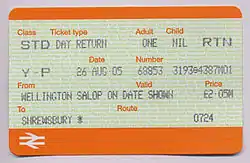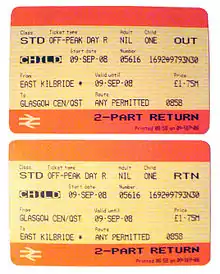National Rail
National Rail (NR) in the United Kingdom is the trading name licensed for use by the Rail Delivery Group, an unincorporated association whose membership consists of the passenger train operating companies (TOCs) of England, Scotland, and Wales. The TOCs run the passenger services previously provided by the British Railways Board, from 1965 using the brand name British Rail. Northern Ireland, which is bordered by the Republic of Ireland, has a different system. National Rail services share a ticketing structure and inter-availability that generally do not extend to services which were not part of British Rail.
 | |
| Product type | Public transport |
|---|---|
| Owner | Rail Delivery Group |
| Country | United Kingdom |
| Introduced | 1999 |
| Related brands | |
| Markets | United Kingdom |
| Website | www |
National Rail and Network Rail


National Rail should not be confused with Network Rail. National Rail is a brand used to promote passenger railway services, and providing some harmonisation for passengers in ticketing, while Network Rail is the organisation which owns and manages most of the fixed assets of the railway network, including tracks, stations and signals.
The two generally coincide where passenger services are run. Most major Network Rail lines also carry freight traffic and some lines are freight only. There are some scheduled passenger services on privately managed, non-Network Rail lines, for example Heathrow Express, which partly runs on Network Rail track. The London Underground also overlaps with Network Rail in places.
Train operating companies (TOCs)
Twenty eight privately owned train operating companies, each franchised for a defined term by government, operate passenger trains on the main rail network in Great Britain. The Rail Delivery Group is the trade association representing the TOCs and provides core services, including the provision of the National Rail Enquiries service. It also runs Rail Settlement Plan, which allocates ticket revenue to the various TOCs, and Rail Staff Travel, which manages travel facilities for railway staff. It does not compile the national timetable, which is the joint responsibility of the Office of Rail Regulation (allocation of paths) and Network Rail (timetable production and publication).
Design and marketing
Since the privatisation of British Rail there is no longer a single approach to design on railways in Great Britain. The look and feel of signage, liveries and marketing material is largely the preserve of the individual TOCs.
However, National Rail continues to use BR's famous double-arrow symbol, designed by Gerald Burney of the Design Research Unit. It has been incorporated in the National Rail logotype and is displayed on tickets, the National Rail website and other publicity. The trademark rights to the double arrow symbol remain state-owned, being vested in the Secretary of State for Transport.[1]
The double arrow symbol is also a generic symbol for a railway station across Great Britain, and is used to indicate a railway station on British traffic signs.[2]
Corporate identity
The National Rail (NR) logo was introduced by ATOC in 1999, and was used on the Great Britain public timetable for the first time in the edition valid from 26 September in that year. Rules for its use are set out in the Corporate Identity Style Guidelines published by the Rail Delivery Group, available on its website.[3] "In 1964 the Design Research Unit—Britain’s first multi-disciplinary design agency founded in 1943 by Misha Black, Milner Gray and Herbert Read—was commissioned to breathe new life into the nation’s neglected railway industry".[4] The NR title is sometimes described as a "brand".[5] As it was used by British Rail, the single operator before franchising, its use also maintains continuity and public familiarity; and it avoids the need to replace signage.
The lettering used in the National Rail logotype is a modified form of the typeface Sassoon Bold. Some train operating companies continue to use the former British Rail Rail Alphabet lettering to varying degrees in station signage, although its use is no longer universal; however it remains compulsory (under Railway Group Standards) for safety signage in trackside areas and is still common (although not universal) on rolling stock.
The British Rail typefaces of choice from 1965 were Helvetica and Univers, with others (particularly Frutiger) coming into use during the sectorisation period after 1983. TOCs may use what they like: examples include Futura (Stagecoach Group), Helvetica (FirstGroup and National Express), Frutiger (Arriva Trains Wales), Bliss (CrossCountry), and a modified version of Precious by London Midland.
Although TOCs compete against each other for franchises, and for passengers on routes where more than one TOC operates, the strapline used with the National Rail logo is 'Britain's train companies working together'.
Other passenger rail operators in Great Britain
Several conurbations have their own metro or tram systems, most of which are not part of National Rail. These include the London Underground, Docklands Light Railway, London Tramlink, Blackpool Tramway, Glasgow Subway, Tyne & Wear Metro, Manchester Metrolink, Sheffield Supertram, West Midlands Metro and Nottingham Express Transit. On the other hand, the largely self-contained Merseyrail system is part of the National Rail network, and urban rail networks around Birmingham, Cardiff, Glasgow and West Yorkshire consist entirely of National Rail services.
London Overground is a hybrid: its services are operated via a concession awarded by Transport for London, and are branded accordingly, but until 2010 all its routes used infrastructure owned by Network Rail, that is because of the East London line which was a London Underground line converted to a mainline but it is still National Rail. London Overground now also owns some infrastructure in its own right, following the reopening of the former London Underground East London line. Since all the previous LO routes were operated by National Rail franchise Silverlink until November 2007, they have continued to be shown in the National Rail timetable and are still considered to be a part of National Rail.
Heathrow Express and Eurostar are also not part of the National Rail network despite sharing of stations (Heathrow Express also share its route with GWR and TfL Rail). Northern Ireland Railways were never part of British Rail, which was limited to England, Scotland and Wales, and therefore are not part of the National Rail network.
There are many privately owned or heritage railways in Great Britain which are not part of the National Rail network and mostly operate for heritage or pleasure purposes rather than as public transport, but some have connections to National rail track.
Ticketing
National Rail services have a common ticketing structure inherited from British Rail. Through tickets are available between any pair of stations on the network, and can be bought from any station ticket office. Most tickets are inter-available between the services of all operators on routes appropriate to the journey being made. Operators on some routes offer operator-specific tickets that are cheaper than the inter-available ones.
Through tickets involving Heathrow Express and London Underground are also available. Oyster pay-as-you-go can be used on National Rail in Greater London from 2 January 2010.[6] These same areas can also be journeyed to using a contactless debit/credit card. Contactless also covers some areas that oyster doesn't such as the Crossrail line to Reading, or the Thameslink station at Oakleigh Park.[7][8]
Passengers without a valid ticket boarding a train at a station where ticket-buying facilities are available are required to pay the full Open Single or Return fare. On some services penalty fares apply - a ticketless passenger may be charged the greater of £20 or twice the full single fare to the next stop. Penalty Fares can be collected only by authorised Revenue Protection Inspectors, not by ordinary Guards.[9]
National Rail distributes a number of technical manuals on which travel on the railways in Great Britain is based, such as the National Rail Conditions of Travel,[10] via their website.
Timetables
Pocket timetables for individual operators or routes are available free at staffed stations. The last official printed timetable with up to 3000 pages was published in 2007. Now the only complete print edition is published by Middleton Press (as of October 2016). A digital version of the full timetable is available as a pdf file without charge on the Network Rail website,[11] however passengers are recommended to obtain their timetables from the individual train companies.
National Rail Enquiries
The National Rail Enquiries website includes a journey planner, fare and live departure information. The site is designed to complement the myriad different websites of Britain's privatised rail companies, so when users have selected which tickets they wish to buy, they are redirected to the most relevant train company website, where they can buy their tickets without booking fees.
In 2012 the website was joined by a mobile app mirroring its functionality. The app is available for iPhone, Android and Windows Phone.[12][13] However Trainline remains the most downloaded rail app in the UK with 9.4 million users.[14]
References
- http://www.ipo.gov.uk Archived 16 October 2011 at the Wayback Machine trade mark EU001733575
- Traffic Signs Regulations and General Directions 2002, Schedule 7
- "National Rail Descriptor Guidelines". National Rail Descriptor Guidelines. Rail Delivery Group. Archived from the original on 7 October 2017. Retrieved 24 October 2017.
- "British Rail's double-arrow logo, by the Design Research Unit". 4 January 2012. Archived from the original on 1 October 2016. Retrieved 1 October 2016.: "British Rail’s double-arrow"
- "Archived copy". Archived from the original on 23 May 2013. Retrieved 5 April 2013.CS1 maint: archived copy as title (link): "National Rail is the collective brand for Britain's train companies working together"
- Matters, Transport for London | Every Journey. "National Rail". Transport for London. Retrieved 19 April 2020.
- "The First Contactless Only Station - Geoff Marshall - Youtube". Youtube. 7 October 2019. Retrieved 19 April 2020.
- Matters, Transport for London | Every Journey. "National Rail fares, caps and Travelcards beyond Zone 9". Transport for London. Retrieved 19 April 2020.
- "National Rail Enquiries - National Rail Conditions of Travel". www.nationalrail.co.uk. Retrieved 19 April 2020.
- "National Rail Conditions of Travel". National Rail. Rail Delivery Group. Archived from the original on 21 October 2017. Retrieved 24 October 2017.
- "Electronic National Rail Timetable". Network Rail. Network Rail. Archived from the original on 30 December 2016. Retrieved 24 October 2017.
- "National Rail Enquiries announces a new app for iPhone & Android". National Rail blog. National Rail Enquiries. 1 May 2012. Archived from the original on 8 October 2016. Retrieved 1 October 2016.
- "Download our FREE app and become more mobile and get FREE alerts". National Rail Enquiries. National Rail. Archived from the original on 30 September 2016. Retrieved 1 October 2016.
- "Mobile App - Trainline". Trainline. Archived from the original on 30 September 2016. Retrieved 1 October 2016.
External links
- National Rail – official website
- Live departure boards – at National Rail